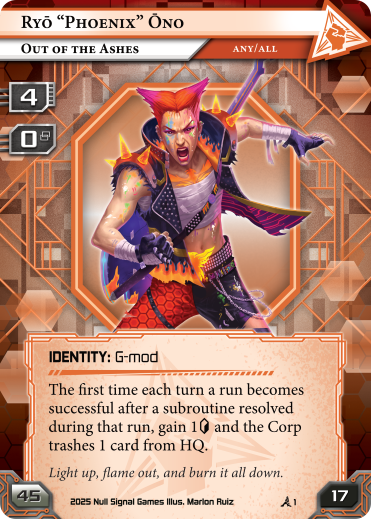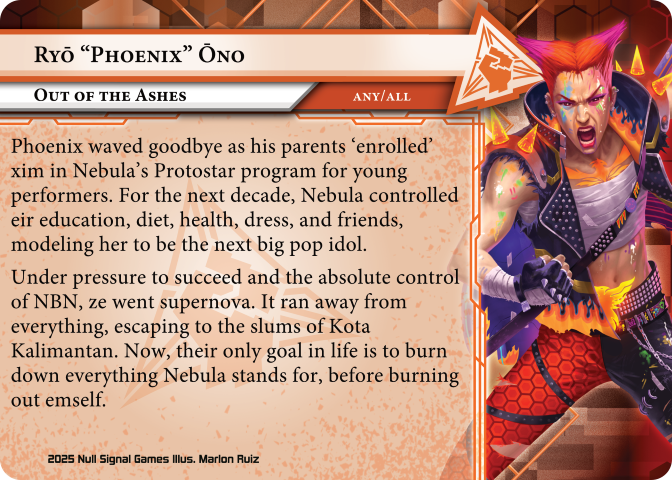Playtester James joins us to debut a new Anarch identity and provide some insight into the new ways to play the faction that it enables.
Anarch has always been about playing aggressive, disrupting the Corp’s game plans By Any Means. But, there’s always a price to pay, be that self-inflicted damage or the risk of retaliation. Balancing the risk and reward is crucial to many Anarch playstyles, and this new identity is no different.
First Un-Impressions
At first glance, the identity might be unintuitive, especially to newer players. The trigger condition seemed paradoxical: how could one make a successful run while having subroutines fired? The reward also looked mild. Instead of drawing a card like Loup, Phoenix is forcing the Corp to drop a card. What could that achieve?
Losing a card removes options from the Corp, which can disrupt combos or just just set them back. What’s more, it improves quality of accesses when breaching HQ, as most Corps are reluctant to trash agendas. And unlike Sabotage, a similar Anarch keyword introduced in the Borealis Cycle, there is no escape via trashing cards from R&D, meaning a Phoenix trigger will often cost the Corp precious clicks to draw back up. (Corps be warned, there are consequences to having an empty HQ in Elevation, besides getting locked out with Stargate.)
If you’ve played Alice Merchant or Maw before, you will know how impactful hand disruption can be. It also synergises with other Anarch cards such as Tsakhia “Bankhar” Gantulga or Banner.
Unbreaking the ICE
As a playtester, I would like to provide a sketch of her gameplay during playtest, so that you can paint the full picture yourselves, in game, when Elevation comes out.
Let’s look at some ice from System Gateway to evaluate the potential of Phoenix.
Tithe becomes an almost symmetric effect, with both sides gaining a credit and losing a card (although your damage is random). As most sentries do not end the run, if you can stomach the pain, you could guarantee some Phoenix disruption.
Whitespace could become free to break with the rebate, as a shrewd Runner could and should navigate through tricky code gate effects. Identifying what subroutines have minimal consequences with your toolkit is crucial for balancing the cost and reward of their ability.
Barriers like Palisade, however, have to be dealt with fair and square, but a Runner can either identify servers that are not all barriers to exploit, or bring tricks like Botulus or Banner to nullify barriers. Phoenix’s ability makes it harder for the Corp to respond to Runner threats, in turn making it easier to trigger xir ability in the future.
These are the best-case scenarios, compared to Karunā or Funhouse that have a significantly higher cost. The ability of Phoenix is not one that will fire every turn, but once he identifies a single weakness in the Corp’s entire board, she can send the Corp scrambling for reinforcements lest their options be slowly chipped away.
Playtesting from a Corp perspective, her ability changes the evaluation of a lot of ice. Damage done with Syailendra is not as attractive anymore, while Jaguarundi now comes with an upkeep cost in the late game. Phoenix creates a unique paradigm asking the Corp to reevaluate when to rez, where to install, and whether to replace their ice. Her ability requires the Corp to carefully create a different gameplan for their defenses from the beginning of the game, something words on the card might not provoke.
Unravelling the Identity
Designing the identity has been tricky. It went through many iterative changes throughout playtesting in Elevation, yet their core tenet is kept consistent: aggression as a cost, disruption as a reward.
His genesis was codenamed “Banner Girl”, siphoning a credit from the Corp the first time a subroutine fired each turn. This first version is definitely not the most Anarch, but the essence of the design is already there. The cost of having to make a run and potentially suffer makes it thematically and mechanically more reckless than Reina Roja, but punishing the Corp for simply ending the run was an unintended side effect. I vividly remember my first game playing against Phoenix, where I felt good rezzing a Palisade discounted with Mahkota Langit Grid, only to have them “farm” the barrier over and over again for the next few turns. It became a liability. Not every deck can slot ample spiky ice, and the 419-esque dynamic was also not what we wanted, so devs explored other forms of costs and rewards.
Over the next few versions, there were big and small adjustments to the identity. Devs experimented with different forms of Sabotage as the reward, while incorporating additional inspirations from The Nihilist (Sabotage unless Corp allows Runner to draw) and Street Magic (allow subroutines on ice to resolve in a reverse order) to spice up the identity. But in the end, we were not satisfied as the play patterns were still the same: in many games “farming” persisted or even worsened, while Corp just dumped a card from R&D every turn the Runner ran. A fancier Nga is not interesting enough to be an identity when Banner Girl is not winning the Sabotage game against Esa.
Our breakthrough during design came halfway through playtest: to require a successful run from the Runner. Soon the reward also improved to match. Forcing an HQ trash is a marked buff over the Sabotage, and all of a sudden we saw many new brews of Phoenix become alive again. Bankhar, Botulus, Docklands Pass as well as several other new cards in Elevation can form different strategies to force successful runs with minimal damage, and different win conditions to exploit the new payout. Corp is happy that their barriers no longer work against them, while Runner is happy to pack a heavier punch. After many changes we finally found the ideal aggression-disruption dynamic for our Phoenix, and I’m sure there are a lot more strategies for everyone to explore.
I had a lot of fun playtesting with and against Phoenix. Overall it has changed from a “value” identity to a more opportunistic, high risk/high reward aggressive Runner. To me, this is highly enjoyable to play that is unique to Netrunner, and I promise there will be discoveries emerging from gameplay with Phoenix beyond what the card text reads.
Join us in Kota Kalimantan when Elevation releases on April 24th 2025!


